Management and Operations Report
VerifiedAdded on 2020/10/22
|15
|4672
|273
Report
AI Summary
This report delves into the roles and characteristics of leaders and managers within the context of operations management, specifically focusing on Marks and Spencer. It discusses various leadership theories, key approaches to operations management, and the importance of effective decision-making in achieving business objectives. The report highlights the significance of operational management in large organizations and the impact of external factors on decision-making processes.
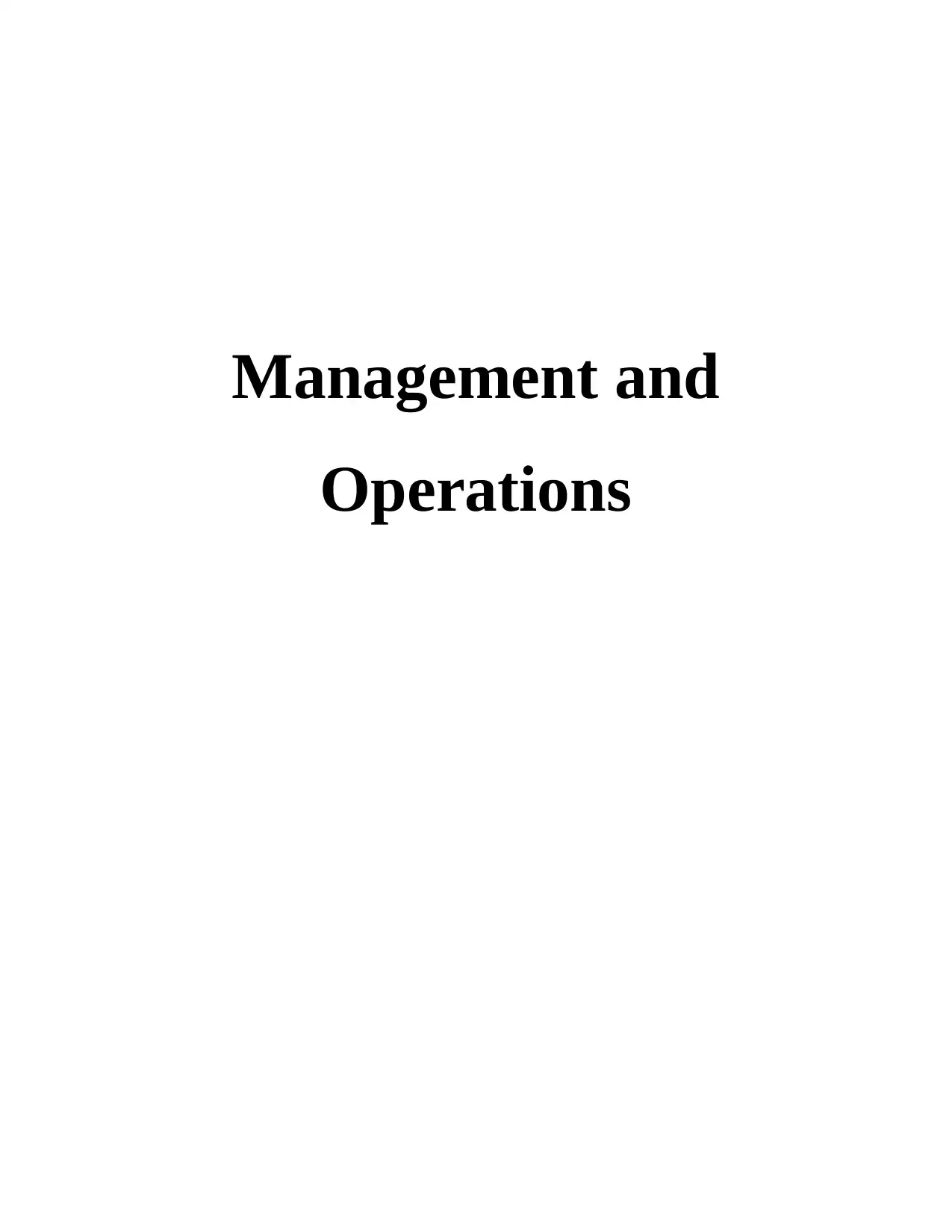
Management and
Operations
Operations
Paraphrase This Document
Need a fresh take? Get an instant paraphrase of this document with our AI Paraphraser
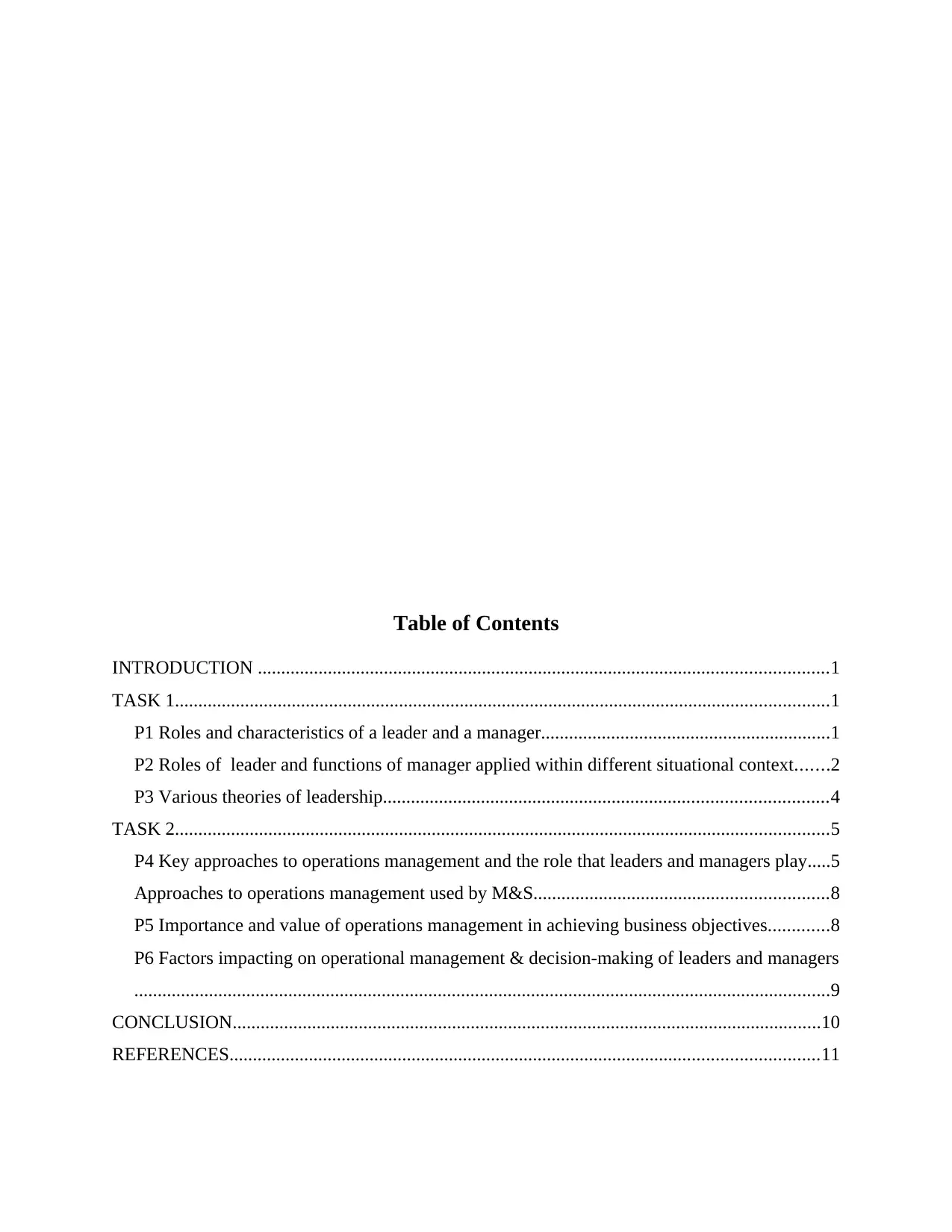
Table of Contents
INTRODUCTION ..........................................................................................................................1
TASK 1............................................................................................................................................1
P1 Roles and characteristics of a leader and a manager..............................................................1
P2 Roles of leader and functions of manager applied within different situational context.......2
P3 Various theories of leadership...............................................................................................4
TASK 2............................................................................................................................................5
P4 Key approaches to operations management and the role that leaders and managers play.....5
Approaches to operations management used by M&S...............................................................8
P5 Importance and value of operations management in achieving business objectives.............8
P6 Factors impacting on operational management & decision-making of leaders and managers
.....................................................................................................................................................9
CONCLUSION..............................................................................................................................10
REFERENCES..............................................................................................................................11
INTRODUCTION ..........................................................................................................................1
TASK 1............................................................................................................................................1
P1 Roles and characteristics of a leader and a manager..............................................................1
P2 Roles of leader and functions of manager applied within different situational context.......2
P3 Various theories of leadership...............................................................................................4
TASK 2............................................................................................................................................5
P4 Key approaches to operations management and the role that leaders and managers play.....5
Approaches to operations management used by M&S...............................................................8
P5 Importance and value of operations management in achieving business objectives.............8
P6 Factors impacting on operational management & decision-making of leaders and managers
.....................................................................................................................................................9
CONCLUSION..............................................................................................................................10
REFERENCES..............................................................................................................................11

⊘ This is a preview!⊘
Do you want full access?
Subscribe today to unlock all pages.

Trusted by 1+ million students worldwide
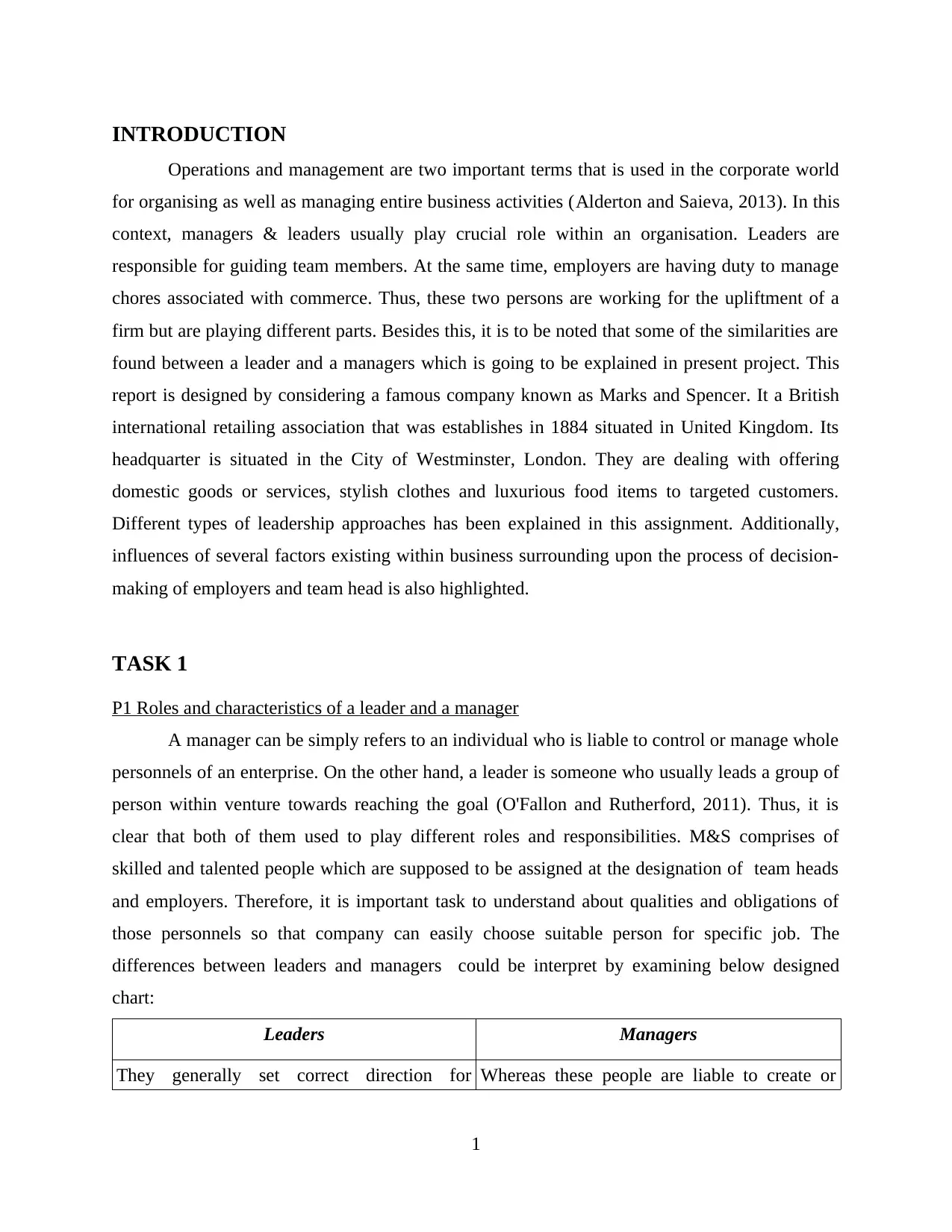
INTRODUCTION
Operations and management are two important terms that is used in the corporate world
for organising as well as managing entire business activities (Alderton and Saieva, 2013). In this
context, managers & leaders usually play crucial role within an organisation. Leaders are
responsible for guiding team members. At the same time, employers are having duty to manage
chores associated with commerce. Thus, these two persons are working for the upliftment of a
firm but are playing different parts. Besides this, it is to be noted that some of the similarities are
found between a leader and a managers which is going to be explained in present project. This
report is designed by considering a famous company known as Marks and Spencer. It a British
international retailing association that was establishes in 1884 situated in United Kingdom. Its
headquarter is situated in the City of Westminster, London. They are dealing with offering
domestic goods or services, stylish clothes and luxurious food items to targeted customers.
Different types of leadership approaches has been explained in this assignment. Additionally,
influences of several factors existing within business surrounding upon the process of decision-
making of employers and team head is also highlighted.
TASK 1
P1 Roles and characteristics of a leader and a manager
A manager can be simply refers to an individual who is liable to control or manage whole
personnels of an enterprise. On the other hand, a leader is someone who usually leads a group of
person within venture towards reaching the goal (O'Fallon and Rutherford, 2011). Thus, it is
clear that both of them used to play different roles and responsibilities. M&S comprises of
skilled and talented people which are supposed to be assigned at the designation of team heads
and employers. Therefore, it is important task to understand about qualities and obligations of
those personnels so that company can easily choose suitable person for specific job. The
differences between leaders and managers could be interpret by examining below designed
chart:
Leaders Managers
They generally set correct direction for Whereas these people are liable to create or
1
Operations and management are two important terms that is used in the corporate world
for organising as well as managing entire business activities (Alderton and Saieva, 2013). In this
context, managers & leaders usually play crucial role within an organisation. Leaders are
responsible for guiding team members. At the same time, employers are having duty to manage
chores associated with commerce. Thus, these two persons are working for the upliftment of a
firm but are playing different parts. Besides this, it is to be noted that some of the similarities are
found between a leader and a managers which is going to be explained in present project. This
report is designed by considering a famous company known as Marks and Spencer. It a British
international retailing association that was establishes in 1884 situated in United Kingdom. Its
headquarter is situated in the City of Westminster, London. They are dealing with offering
domestic goods or services, stylish clothes and luxurious food items to targeted customers.
Different types of leadership approaches has been explained in this assignment. Additionally,
influences of several factors existing within business surrounding upon the process of decision-
making of employers and team head is also highlighted.
TASK 1
P1 Roles and characteristics of a leader and a manager
A manager can be simply refers to an individual who is liable to control or manage whole
personnels of an enterprise. On the other hand, a leader is someone who usually leads a group of
person within venture towards reaching the goal (O'Fallon and Rutherford, 2011). Thus, it is
clear that both of them used to play different roles and responsibilities. M&S comprises of
skilled and talented people which are supposed to be assigned at the designation of team heads
and employers. Therefore, it is important task to understand about qualities and obligations of
those personnels so that company can easily choose suitable person for specific job. The
differences between leaders and managers could be interpret by examining below designed
chart:
Leaders Managers
They generally set correct direction for Whereas these people are liable to create or
1
Paraphrase This Document
Need a fresh take? Get an instant paraphrase of this document with our AI Paraphraser
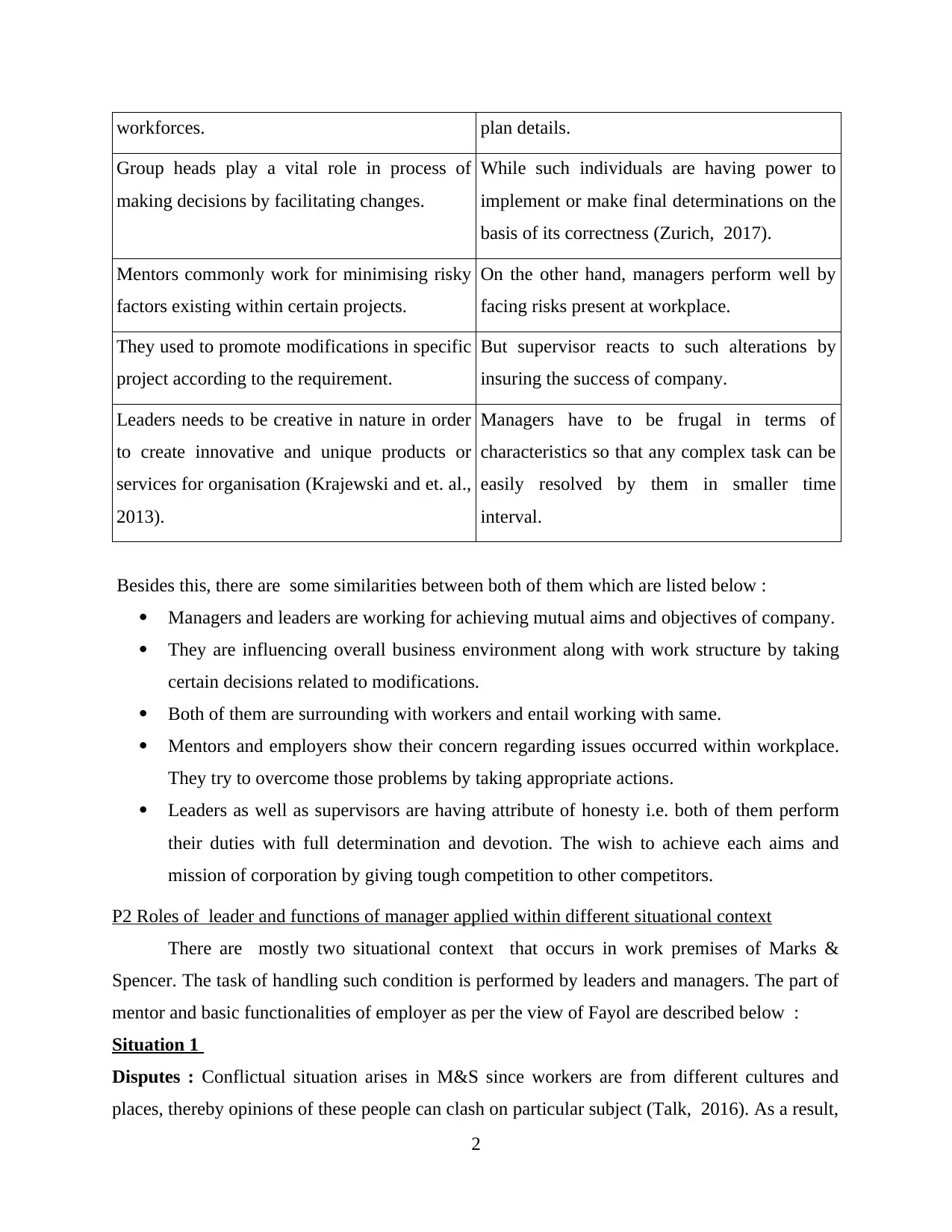
workforces. plan details.
Group heads play a vital role in process of
making decisions by facilitating changes.
While such individuals are having power to
implement or make final determinations on the
basis of its correctness (Zurich, 2017).
Mentors commonly work for minimising risky
factors existing within certain projects.
On the other hand, managers perform well by
facing risks present at workplace.
They used to promote modifications in specific
project according to the requirement.
But supervisor reacts to such alterations by
insuring the success of company.
Leaders needs to be creative in nature in order
to create innovative and unique products or
services for organisation (Krajewski and et. al.,
2013).
Managers have to be frugal in terms of
characteristics so that any complex task can be
easily resolved by them in smaller time
interval.
Besides this, there are some similarities between both of them which are listed below :
Managers and leaders are working for achieving mutual aims and objectives of company.
They are influencing overall business environment along with work structure by taking
certain decisions related to modifications.
Both of them are surrounding with workers and entail working with same.
Mentors and employers show their concern regarding issues occurred within workplace.
They try to overcome those problems by taking appropriate actions.
Leaders as well as supervisors are having attribute of honesty i.e. both of them perform
their duties with full determination and devotion. The wish to achieve each aims and
mission of corporation by giving tough competition to other competitors.
P2 Roles of leader and functions of manager applied within different situational context
There are mostly two situational context that occurs in work premises of Marks &
Spencer. The task of handling such condition is performed by leaders and managers. The part of
mentor and basic functionalities of employer as per the view of Fayol are described below :
Situation 1
Disputes : Conflictual situation arises in M&S since workers are from different cultures and
places, thereby opinions of these people can clash on particular subject (Talk, 2016). As a result,
2
Group heads play a vital role in process of
making decisions by facilitating changes.
While such individuals are having power to
implement or make final determinations on the
basis of its correctness (Zurich, 2017).
Mentors commonly work for minimising risky
factors existing within certain projects.
On the other hand, managers perform well by
facing risks present at workplace.
They used to promote modifications in specific
project according to the requirement.
But supervisor reacts to such alterations by
insuring the success of company.
Leaders needs to be creative in nature in order
to create innovative and unique products or
services for organisation (Krajewski and et. al.,
2013).
Managers have to be frugal in terms of
characteristics so that any complex task can be
easily resolved by them in smaller time
interval.
Besides this, there are some similarities between both of them which are listed below :
Managers and leaders are working for achieving mutual aims and objectives of company.
They are influencing overall business environment along with work structure by taking
certain decisions related to modifications.
Both of them are surrounding with workers and entail working with same.
Mentors and employers show their concern regarding issues occurred within workplace.
They try to overcome those problems by taking appropriate actions.
Leaders as well as supervisors are having attribute of honesty i.e. both of them perform
their duties with full determination and devotion. The wish to achieve each aims and
mission of corporation by giving tough competition to other competitors.
P2 Roles of leader and functions of manager applied within different situational context
There are mostly two situational context that occurs in work premises of Marks &
Spencer. The task of handling such condition is performed by leaders and managers. The part of
mentor and basic functionalities of employer as per the view of Fayol are described below :
Situation 1
Disputes : Conflictual situation arises in M&S since workers are from different cultures and
places, thereby opinions of these people can clash on particular subject (Talk, 2016). As a result,
2
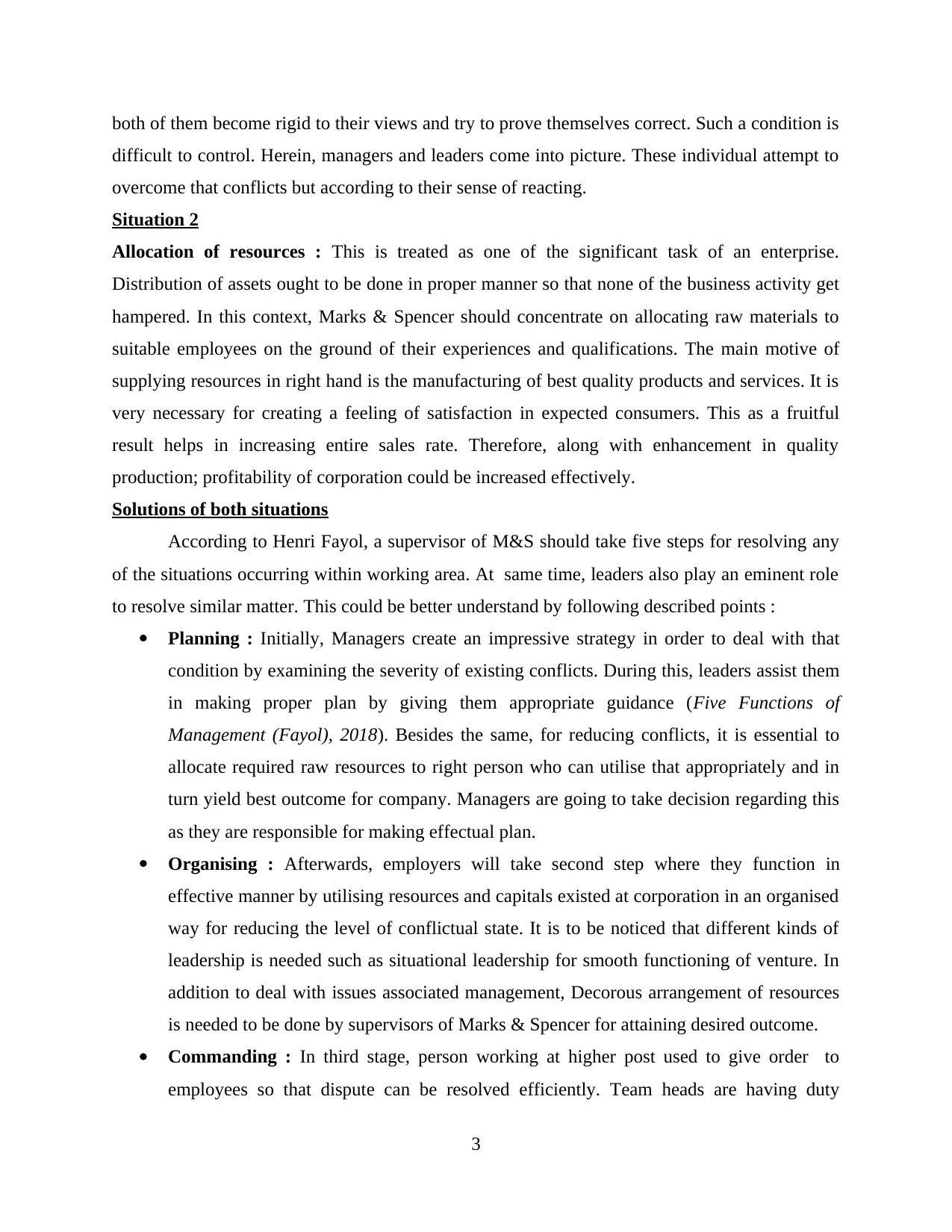
both of them become rigid to their views and try to prove themselves correct. Such a condition is
difficult to control. Herein, managers and leaders come into picture. These individual attempt to
overcome that conflicts but according to their sense of reacting.
Situation 2
Allocation of resources : This is treated as one of the significant task of an enterprise.
Distribution of assets ought to be done in proper manner so that none of the business activity get
hampered. In this context, Marks & Spencer should concentrate on allocating raw materials to
suitable employees on the ground of their experiences and qualifications. The main motive of
supplying resources in right hand is the manufacturing of best quality products and services. It is
very necessary for creating a feeling of satisfaction in expected consumers. This as a fruitful
result helps in increasing entire sales rate. Therefore, along with enhancement in quality
production; profitability of corporation could be increased effectively.
Solutions of both situations
According to Henri Fayol, a supervisor of M&S should take five steps for resolving any
of the situations occurring within working area. At same time, leaders also play an eminent role
to resolve similar matter. This could be better understand by following described points :
Planning : Initially, Managers create an impressive strategy in order to deal with that
condition by examining the severity of existing conflicts. During this, leaders assist them
in making proper plan by giving them appropriate guidance (Five Functions of
Management (Fayol), 2018). Besides the same, for reducing conflicts, it is essential to
allocate required raw resources to right person who can utilise that appropriately and in
turn yield best outcome for company. Managers are going to take decision regarding this
as they are responsible for making effectual plan.
Organising : Afterwards, employers will take second step where they function in
effective manner by utilising resources and capitals existed at corporation in an organised
way for reducing the level of conflictual state. It is to be noticed that different kinds of
leadership is needed such as situational leadership for smooth functioning of venture. In
addition to deal with issues associated management, Decorous arrangement of resources
is needed to be done by supervisors of Marks & Spencer for attaining desired outcome.
Commanding : In third stage, person working at higher post used to give order to
employees so that dispute can be resolved efficiently. Team heads are having duty
3
difficult to control. Herein, managers and leaders come into picture. These individual attempt to
overcome that conflicts but according to their sense of reacting.
Situation 2
Allocation of resources : This is treated as one of the significant task of an enterprise.
Distribution of assets ought to be done in proper manner so that none of the business activity get
hampered. In this context, Marks & Spencer should concentrate on allocating raw materials to
suitable employees on the ground of their experiences and qualifications. The main motive of
supplying resources in right hand is the manufacturing of best quality products and services. It is
very necessary for creating a feeling of satisfaction in expected consumers. This as a fruitful
result helps in increasing entire sales rate. Therefore, along with enhancement in quality
production; profitability of corporation could be increased effectively.
Solutions of both situations
According to Henri Fayol, a supervisor of M&S should take five steps for resolving any
of the situations occurring within working area. At same time, leaders also play an eminent role
to resolve similar matter. This could be better understand by following described points :
Planning : Initially, Managers create an impressive strategy in order to deal with that
condition by examining the severity of existing conflicts. During this, leaders assist them
in making proper plan by giving them appropriate guidance (Five Functions of
Management (Fayol), 2018). Besides the same, for reducing conflicts, it is essential to
allocate required raw resources to right person who can utilise that appropriately and in
turn yield best outcome for company. Managers are going to take decision regarding this
as they are responsible for making effectual plan.
Organising : Afterwards, employers will take second step where they function in
effective manner by utilising resources and capitals existed at corporation in an organised
way for reducing the level of conflictual state. It is to be noticed that different kinds of
leadership is needed such as situational leadership for smooth functioning of venture. In
addition to deal with issues associated management, Decorous arrangement of resources
is needed to be done by supervisors of Marks & Spencer for attaining desired outcome.
Commanding : In third stage, person working at higher post used to give order to
employees so that dispute can be resolved efficiently. Team heads are having duty
3
⊘ This is a preview!⊘
Do you want full access?
Subscribe today to unlock all pages.

Trusted by 1+ million students worldwide
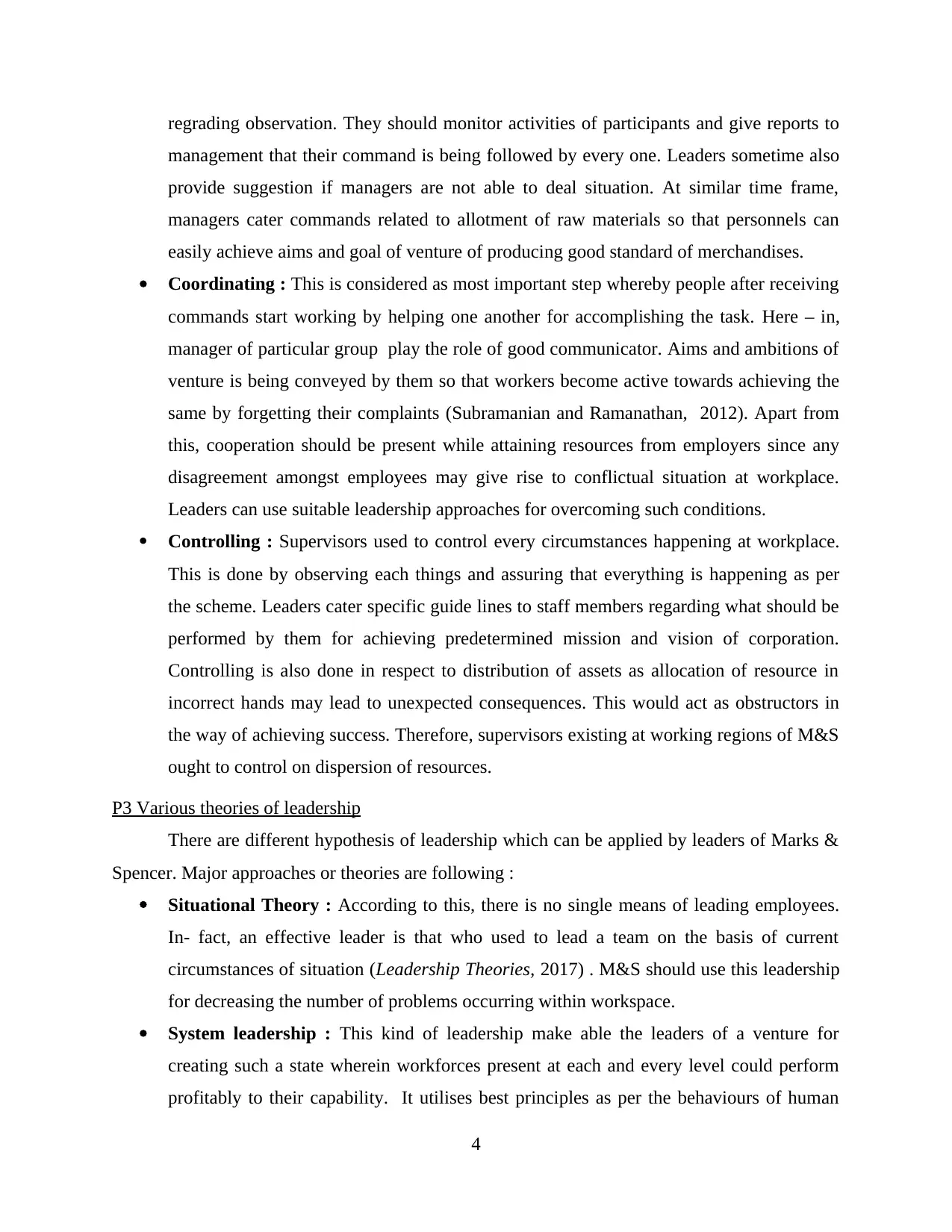
regrading observation. They should monitor activities of participants and give reports to
management that their command is being followed by every one. Leaders sometime also
provide suggestion if managers are not able to deal situation. At similar time frame,
managers cater commands related to allotment of raw materials so that personnels can
easily achieve aims and goal of venture of producing good standard of merchandises.
Coordinating : This is considered as most important step whereby people after receiving
commands start working by helping one another for accomplishing the task. Here – in,
manager of particular group play the role of good communicator. Aims and ambitions of
venture is being conveyed by them so that workers become active towards achieving the
same by forgetting their complaints (Subramanian and Ramanathan, 2012). Apart from
this, cooperation should be present while attaining resources from employers since any
disagreement amongst employees may give rise to conflictual situation at workplace.
Leaders can use suitable leadership approaches for overcoming such conditions.
Controlling : Supervisors used to control every circumstances happening at workplace.
This is done by observing each things and assuring that everything is happening as per
the scheme. Leaders cater specific guide lines to staff members regarding what should be
performed by them for achieving predetermined mission and vision of corporation.
Controlling is also done in respect to distribution of assets as allocation of resource in
incorrect hands may lead to unexpected consequences. This would act as obstructors in
the way of achieving success. Therefore, supervisors existing at working regions of M&S
ought to control on dispersion of resources.
P3 Various theories of leadership
There are different hypothesis of leadership which can be applied by leaders of Marks &
Spencer. Major approaches or theories are following :
Situational Theory : According to this, there is no single means of leading employees.
In- fact, an effective leader is that who used to lead a team on the basis of current
circumstances of situation (Leadership Theories, 2017) . M&S should use this leadership
for decreasing the number of problems occurring within workspace.
System leadership : This kind of leadership make able the leaders of a venture for
creating such a state wherein workforces present at each and every level could perform
profitably to their capability. It utilises best principles as per the behaviours of human
4
management that their command is being followed by every one. Leaders sometime also
provide suggestion if managers are not able to deal situation. At similar time frame,
managers cater commands related to allotment of raw materials so that personnels can
easily achieve aims and goal of venture of producing good standard of merchandises.
Coordinating : This is considered as most important step whereby people after receiving
commands start working by helping one another for accomplishing the task. Here – in,
manager of particular group play the role of good communicator. Aims and ambitions of
venture is being conveyed by them so that workers become active towards achieving the
same by forgetting their complaints (Subramanian and Ramanathan, 2012). Apart from
this, cooperation should be present while attaining resources from employers since any
disagreement amongst employees may give rise to conflictual situation at workplace.
Leaders can use suitable leadership approaches for overcoming such conditions.
Controlling : Supervisors used to control every circumstances happening at workplace.
This is done by observing each things and assuring that everything is happening as per
the scheme. Leaders cater specific guide lines to staff members regarding what should be
performed by them for achieving predetermined mission and vision of corporation.
Controlling is also done in respect to distribution of assets as allocation of resource in
incorrect hands may lead to unexpected consequences. This would act as obstructors in
the way of achieving success. Therefore, supervisors existing at working regions of M&S
ought to control on dispersion of resources.
P3 Various theories of leadership
There are different hypothesis of leadership which can be applied by leaders of Marks &
Spencer. Major approaches or theories are following :
Situational Theory : According to this, there is no single means of leading employees.
In- fact, an effective leader is that who used to lead a team on the basis of current
circumstances of situation (Leadership Theories, 2017) . M&S should use this leadership
for decreasing the number of problems occurring within workspace.
System leadership : This kind of leadership make able the leaders of a venture for
creating such a state wherein workforces present at each and every level could perform
profitably to their capability. It utilises best principles as per the behaviours of human
4
Paraphrase This Document
Need a fresh take? Get an instant paraphrase of this document with our AI Paraphraser
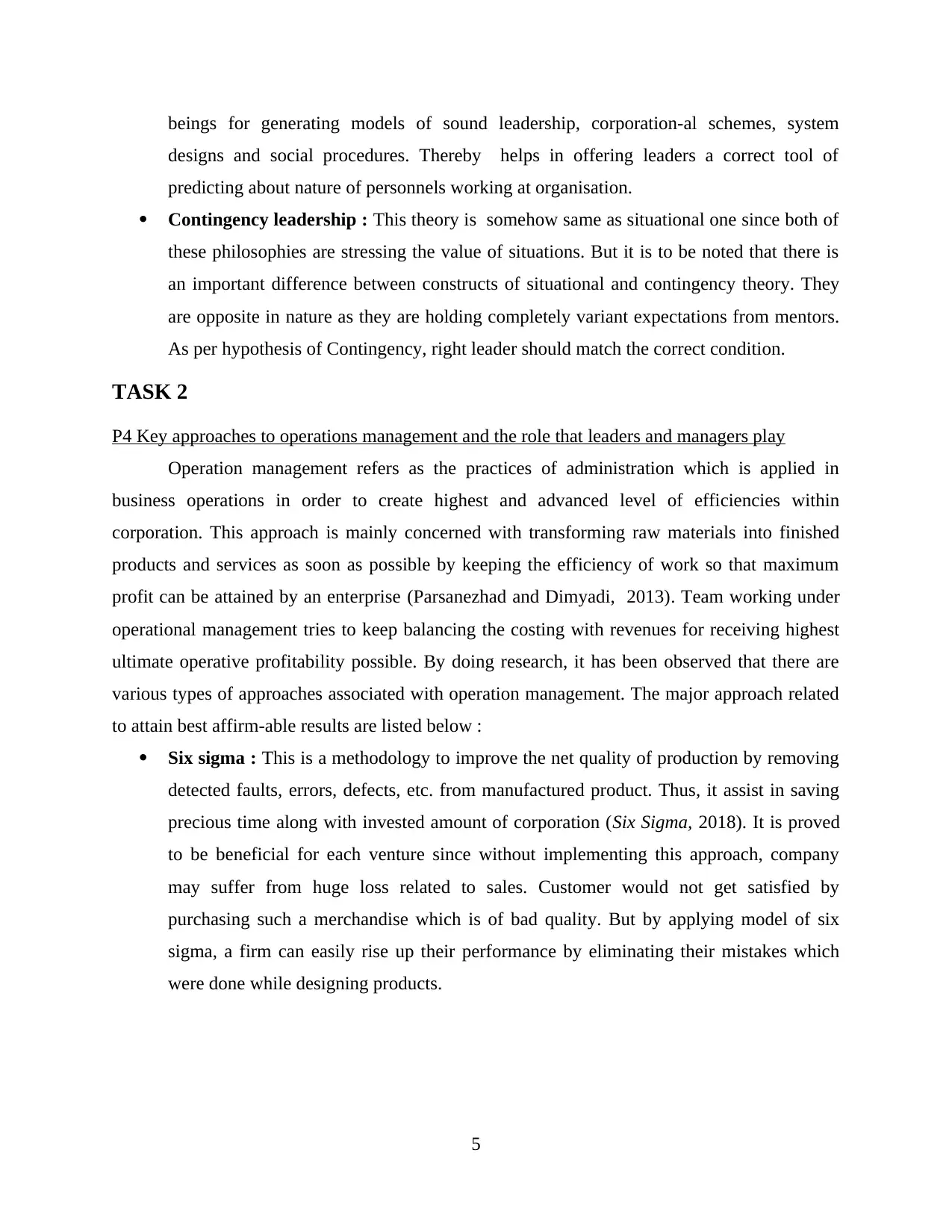
beings for generating models of sound leadership, corporation-al schemes, system
designs and social procedures. Thereby helps in offering leaders a correct tool of
predicting about nature of personnels working at organisation.
Contingency leadership : This theory is somehow same as situational one since both of
these philosophies are stressing the value of situations. But it is to be noted that there is
an important difference between constructs of situational and contingency theory. They
are opposite in nature as they are holding completely variant expectations from mentors.
As per hypothesis of Contingency, right leader should match the correct condition.
TASK 2
P4 Key approaches to operations management and the role that leaders and managers play
Operation management refers as the practices of administration which is applied in
business operations in order to create highest and advanced level of efficiencies within
corporation. This approach is mainly concerned with transforming raw materials into finished
products and services as soon as possible by keeping the efficiency of work so that maximum
profit can be attained by an enterprise (Parsanezhad and Dimyadi, 2013). Team working under
operational management tries to keep balancing the costing with revenues for receiving highest
ultimate operative profitability possible. By doing research, it has been observed that there are
various types of approaches associated with operation management. The major approach related
to attain best affirm-able results are listed below :
Six sigma : This is a methodology to improve the net quality of production by removing
detected faults, errors, defects, etc. from manufactured product. Thus, it assist in saving
precious time along with invested amount of corporation (Six Sigma, 2018). It is proved
to be beneficial for each venture since without implementing this approach, company
may suffer from huge loss related to sales. Customer would not get satisfied by
purchasing such a merchandise which is of bad quality. But by applying model of six
sigma, a firm can easily rise up their performance by eliminating their mistakes which
were done while designing products.
5
designs and social procedures. Thereby helps in offering leaders a correct tool of
predicting about nature of personnels working at organisation.
Contingency leadership : This theory is somehow same as situational one since both of
these philosophies are stressing the value of situations. But it is to be noted that there is
an important difference between constructs of situational and contingency theory. They
are opposite in nature as they are holding completely variant expectations from mentors.
As per hypothesis of Contingency, right leader should match the correct condition.
TASK 2
P4 Key approaches to operations management and the role that leaders and managers play
Operation management refers as the practices of administration which is applied in
business operations in order to create highest and advanced level of efficiencies within
corporation. This approach is mainly concerned with transforming raw materials into finished
products and services as soon as possible by keeping the efficiency of work so that maximum
profit can be attained by an enterprise (Parsanezhad and Dimyadi, 2013). Team working under
operational management tries to keep balancing the costing with revenues for receiving highest
ultimate operative profitability possible. By doing research, it has been observed that there are
various types of approaches associated with operation management. The major approach related
to attain best affirm-able results are listed below :
Six sigma : This is a methodology to improve the net quality of production by removing
detected faults, errors, defects, etc. from manufactured product. Thus, it assist in saving
precious time along with invested amount of corporation (Six Sigma, 2018). It is proved
to be beneficial for each venture since without implementing this approach, company
may suffer from huge loss related to sales. Customer would not get satisfied by
purchasing such a merchandise which is of bad quality. But by applying model of six
sigma, a firm can easily rise up their performance by eliminating their mistakes which
were done while designing products.
5
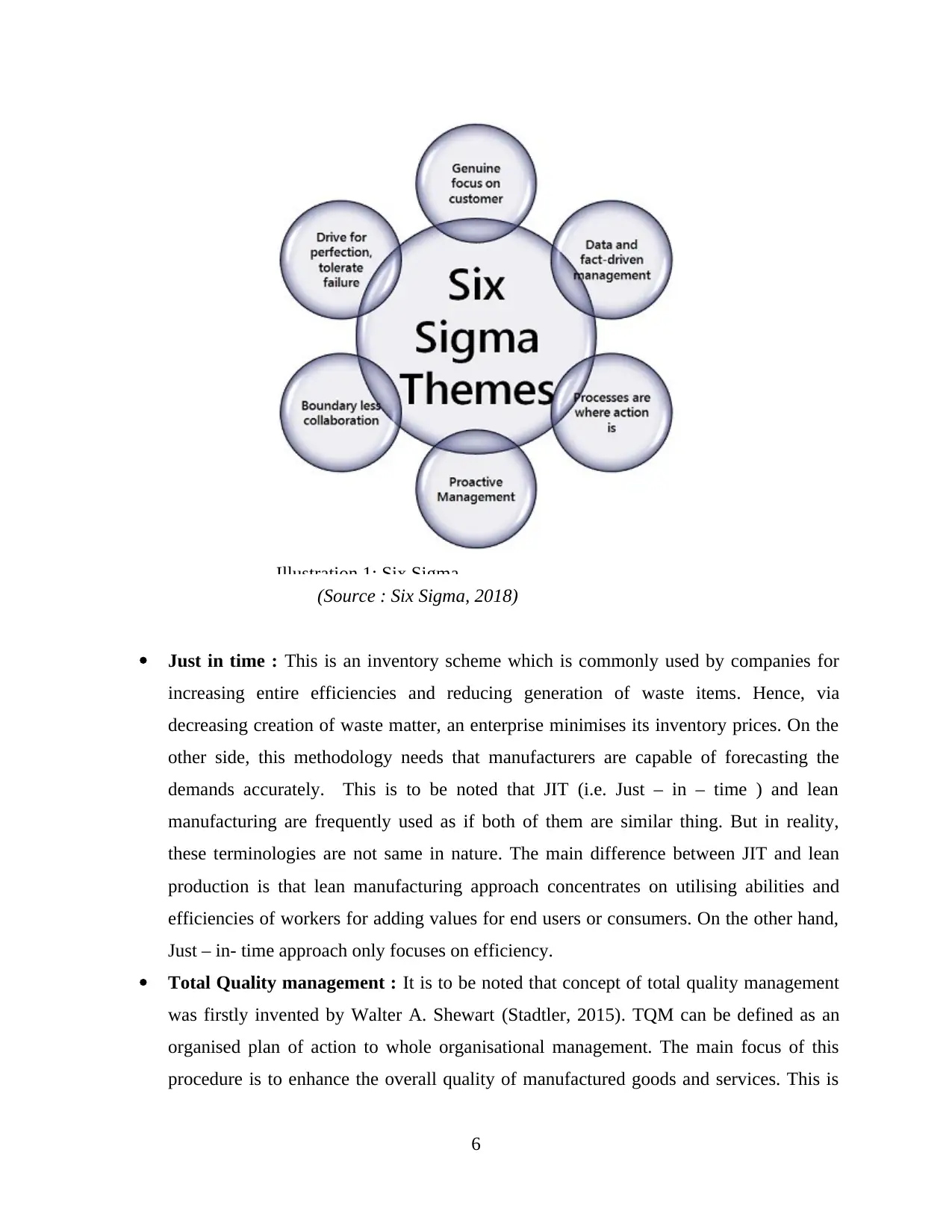
(Source : Six Sigma, 2018)
Just in time : This is an inventory scheme which is commonly used by companies for
increasing entire efficiencies and reducing generation of waste items. Hence, via
decreasing creation of waste matter, an enterprise minimises its inventory prices. On the
other side, this methodology needs that manufacturers are capable of forecasting the
demands accurately. This is to be noted that JIT (i.e. Just – in – time ) and lean
manufacturing are frequently used as if both of them are similar thing. But in reality,
these terminologies are not same in nature. The main difference between JIT and lean
production is that lean manufacturing approach concentrates on utilising abilities and
efficiencies of workers for adding values for end users or consumers. On the other hand,
Just – in- time approach only focuses on efficiency.
Total Quality management : It is to be noted that concept of total quality management
was firstly invented by Walter A. Shewart (Stadtler, 2015). TQM can be defined as an
organised plan of action to whole organisational management. The main focus of this
procedure is to enhance the overall quality of manufactured goods and services. This is
6
Illustration 1: Six Sigma
Just in time : This is an inventory scheme which is commonly used by companies for
increasing entire efficiencies and reducing generation of waste items. Hence, via
decreasing creation of waste matter, an enterprise minimises its inventory prices. On the
other side, this methodology needs that manufacturers are capable of forecasting the
demands accurately. This is to be noted that JIT (i.e. Just – in – time ) and lean
manufacturing are frequently used as if both of them are similar thing. But in reality,
these terminologies are not same in nature. The main difference between JIT and lean
production is that lean manufacturing approach concentrates on utilising abilities and
efficiencies of workers for adding values for end users or consumers. On the other hand,
Just – in- time approach only focuses on efficiency.
Total Quality management : It is to be noted that concept of total quality management
was firstly invented by Walter A. Shewart (Stadtler, 2015). TQM can be defined as an
organised plan of action to whole organisational management. The main focus of this
procedure is to enhance the overall quality of manufactured goods and services. This is
6
Illustration 1: Six Sigma
⊘ This is a preview!⊘
Do you want full access?
Subscribe today to unlock all pages.

Trusted by 1+ million students worldwide
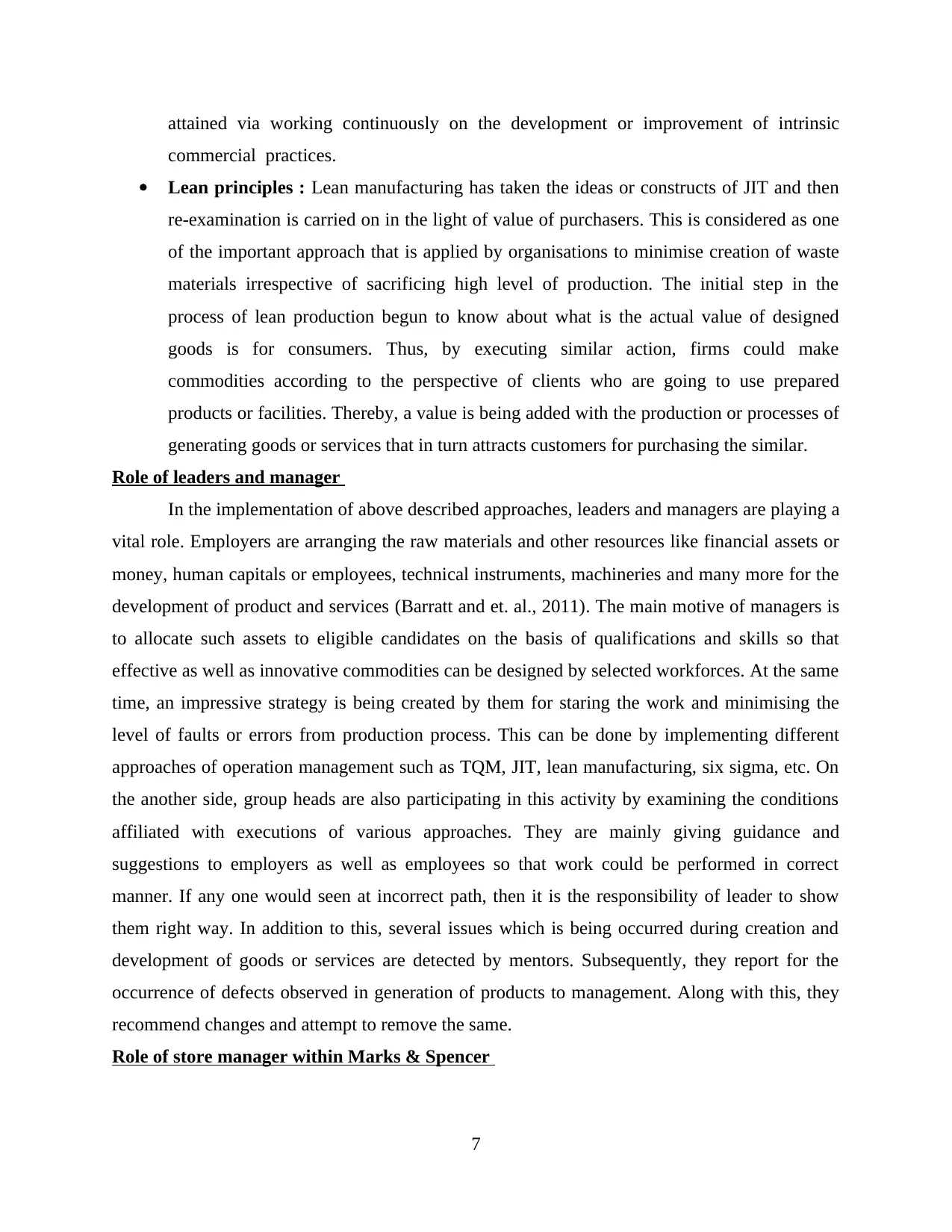
attained via working continuously on the development or improvement of intrinsic
commercial practices.
Lean principles : Lean manufacturing has taken the ideas or constructs of JIT and then
re-examination is carried on in the light of value of purchasers. This is considered as one
of the important approach that is applied by organisations to minimise creation of waste
materials irrespective of sacrificing high level of production. The initial step in the
process of lean production begun to know about what is the actual value of designed
goods is for consumers. Thus, by executing similar action, firms could make
commodities according to the perspective of clients who are going to use prepared
products or facilities. Thereby, a value is being added with the production or processes of
generating goods or services that in turn attracts customers for purchasing the similar.
Role of leaders and manager
In the implementation of above described approaches, leaders and managers are playing a
vital role. Employers are arranging the raw materials and other resources like financial assets or
money, human capitals or employees, technical instruments, machineries and many more for the
development of product and services (Barratt and et. al., 2011). The main motive of managers is
to allocate such assets to eligible candidates on the basis of qualifications and skills so that
effective as well as innovative commodities can be designed by selected workforces. At the same
time, an impressive strategy is being created by them for staring the work and minimising the
level of faults or errors from production process. This can be done by implementing different
approaches of operation management such as TQM, JIT, lean manufacturing, six sigma, etc. On
the another side, group heads are also participating in this activity by examining the conditions
affiliated with executions of various approaches. They are mainly giving guidance and
suggestions to employers as well as employees so that work could be performed in correct
manner. If any one would seen at incorrect path, then it is the responsibility of leader to show
them right way. In addition to this, several issues which is being occurred during creation and
development of goods or services are detected by mentors. Subsequently, they report for the
occurrence of defects observed in generation of products to management. Along with this, they
recommend changes and attempt to remove the same.
Role of store manager within Marks & Spencer
7
commercial practices.
Lean principles : Lean manufacturing has taken the ideas or constructs of JIT and then
re-examination is carried on in the light of value of purchasers. This is considered as one
of the important approach that is applied by organisations to minimise creation of waste
materials irrespective of sacrificing high level of production. The initial step in the
process of lean production begun to know about what is the actual value of designed
goods is for consumers. Thus, by executing similar action, firms could make
commodities according to the perspective of clients who are going to use prepared
products or facilities. Thereby, a value is being added with the production or processes of
generating goods or services that in turn attracts customers for purchasing the similar.
Role of leaders and manager
In the implementation of above described approaches, leaders and managers are playing a
vital role. Employers are arranging the raw materials and other resources like financial assets or
money, human capitals or employees, technical instruments, machineries and many more for the
development of product and services (Barratt and et. al., 2011). The main motive of managers is
to allocate such assets to eligible candidates on the basis of qualifications and skills so that
effective as well as innovative commodities can be designed by selected workforces. At the same
time, an impressive strategy is being created by them for staring the work and minimising the
level of faults or errors from production process. This can be done by implementing different
approaches of operation management such as TQM, JIT, lean manufacturing, six sigma, etc. On
the another side, group heads are also participating in this activity by examining the conditions
affiliated with executions of various approaches. They are mainly giving guidance and
suggestions to employers as well as employees so that work could be performed in correct
manner. If any one would seen at incorrect path, then it is the responsibility of leader to show
them right way. In addition to this, several issues which is being occurred during creation and
development of goods or services are detected by mentors. Subsequently, they report for the
occurrence of defects observed in generation of products to management. Along with this, they
recommend changes and attempt to remove the same.
Role of store manager within Marks & Spencer
7
Paraphrase This Document
Need a fresh take? Get an instant paraphrase of this document with our AI Paraphraser
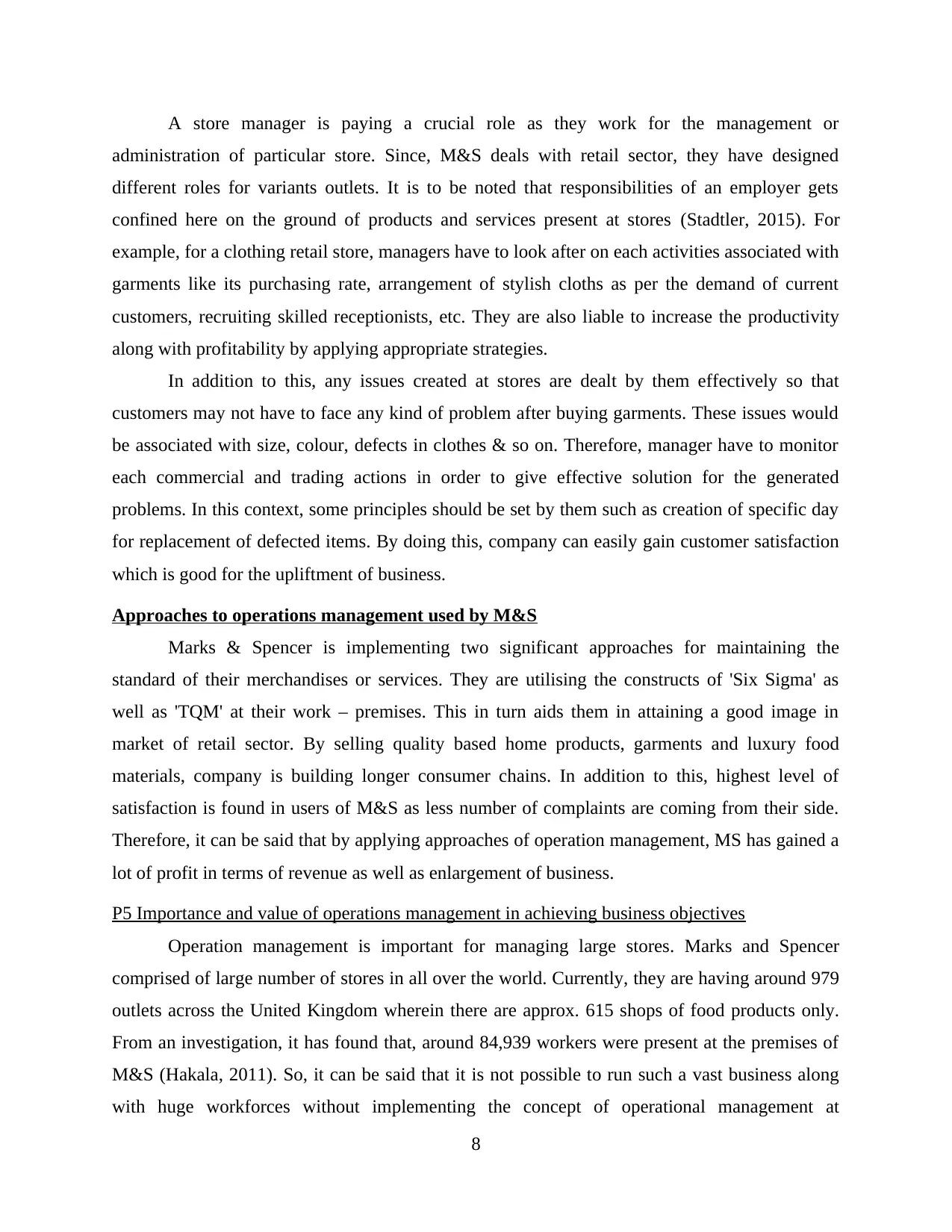
A store manager is paying a crucial role as they work for the management or
administration of particular store. Since, M&S deals with retail sector, they have designed
different roles for variants outlets. It is to be noted that responsibilities of an employer gets
confined here on the ground of products and services present at stores (Stadtler, 2015). For
example, for a clothing retail store, managers have to look after on each activities associated with
garments like its purchasing rate, arrangement of stylish cloths as per the demand of current
customers, recruiting skilled receptionists, etc. They are also liable to increase the productivity
along with profitability by applying appropriate strategies.
In addition to this, any issues created at stores are dealt by them effectively so that
customers may not have to face any kind of problem after buying garments. These issues would
be associated with size, colour, defects in clothes & so on. Therefore, manager have to monitor
each commercial and trading actions in order to give effective solution for the generated
problems. In this context, some principles should be set by them such as creation of specific day
for replacement of defected items. By doing this, company can easily gain customer satisfaction
which is good for the upliftment of business.
Approaches to operations management used by M&S
Marks & Spencer is implementing two significant approaches for maintaining the
standard of their merchandises or services. They are utilising the constructs of 'Six Sigma' as
well as 'TQM' at their work – premises. This in turn aids them in attaining a good image in
market of retail sector. By selling quality based home products, garments and luxury food
materials, company is building longer consumer chains. In addition to this, highest level of
satisfaction is found in users of M&S as less number of complaints are coming from their side.
Therefore, it can be said that by applying approaches of operation management, MS has gained a
lot of profit in terms of revenue as well as enlargement of business.
P5 Importance and value of operations management in achieving business objectives
Operation management is important for managing large stores. Marks and Spencer
comprised of large number of stores in all over the world. Currently, they are having around 979
outlets across the United Kingdom wherein there are approx. 615 shops of food products only.
From an investigation, it has found that, around 84,939 workers were present at the premises of
M&S (Hakala, 2011). So, it can be said that it is not possible to run such a vast business along
with huge workforces without implementing the concept of operational management at
8
administration of particular store. Since, M&S deals with retail sector, they have designed
different roles for variants outlets. It is to be noted that responsibilities of an employer gets
confined here on the ground of products and services present at stores (Stadtler, 2015). For
example, for a clothing retail store, managers have to look after on each activities associated with
garments like its purchasing rate, arrangement of stylish cloths as per the demand of current
customers, recruiting skilled receptionists, etc. They are also liable to increase the productivity
along with profitability by applying appropriate strategies.
In addition to this, any issues created at stores are dealt by them effectively so that
customers may not have to face any kind of problem after buying garments. These issues would
be associated with size, colour, defects in clothes & so on. Therefore, manager have to monitor
each commercial and trading actions in order to give effective solution for the generated
problems. In this context, some principles should be set by them such as creation of specific day
for replacement of defected items. By doing this, company can easily gain customer satisfaction
which is good for the upliftment of business.
Approaches to operations management used by M&S
Marks & Spencer is implementing two significant approaches for maintaining the
standard of their merchandises or services. They are utilising the constructs of 'Six Sigma' as
well as 'TQM' at their work – premises. This in turn aids them in attaining a good image in
market of retail sector. By selling quality based home products, garments and luxury food
materials, company is building longer consumer chains. In addition to this, highest level of
satisfaction is found in users of M&S as less number of complaints are coming from their side.
Therefore, it can be said that by applying approaches of operation management, MS has gained a
lot of profit in terms of revenue as well as enlargement of business.
P5 Importance and value of operations management in achieving business objectives
Operation management is important for managing large stores. Marks and Spencer
comprised of large number of stores in all over the world. Currently, they are having around 979
outlets across the United Kingdom wherein there are approx. 615 shops of food products only.
From an investigation, it has found that, around 84,939 workers were present at the premises of
M&S (Hakala, 2011). So, it can be said that it is not possible to run such a vast business along
with huge workforces without implementing the concept of operational management at
8
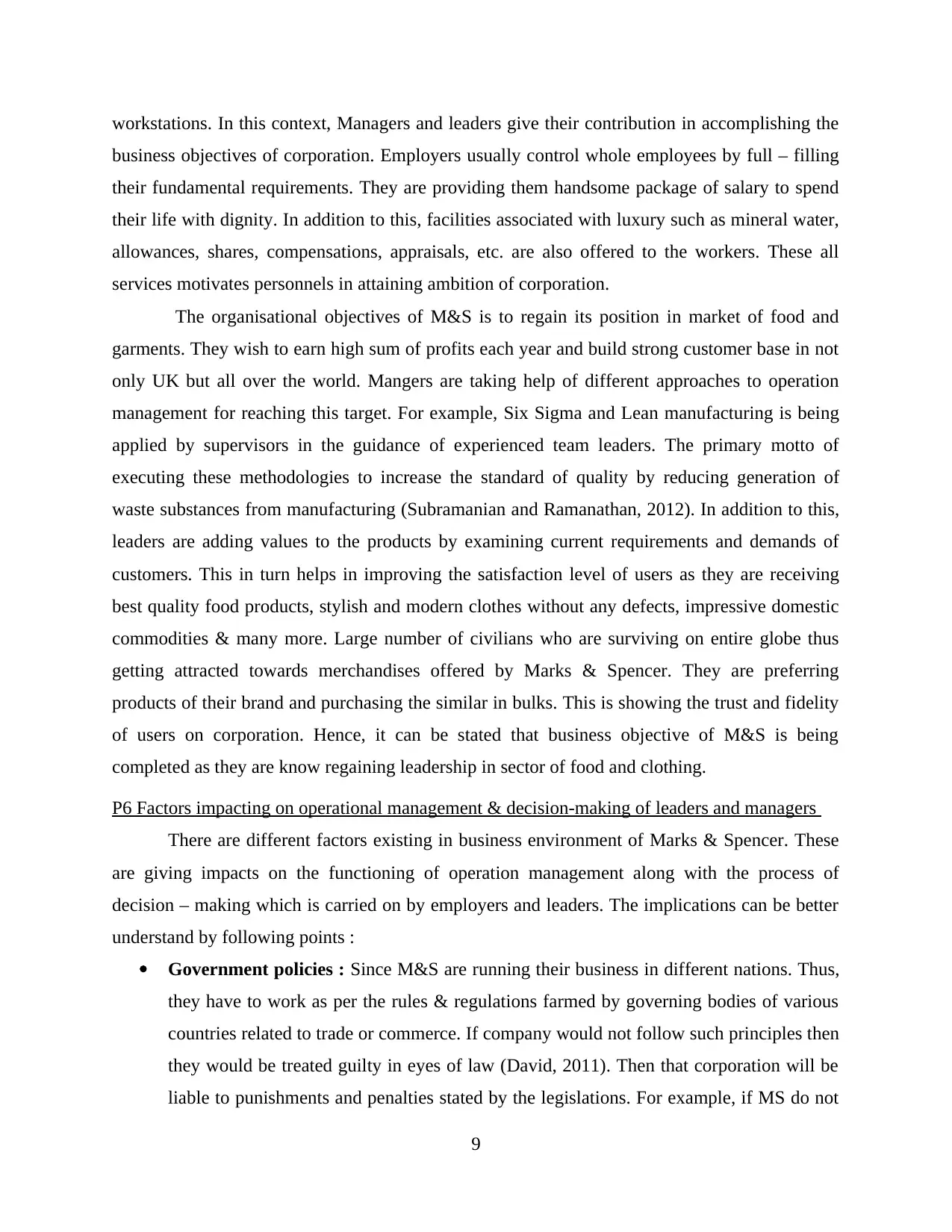
workstations. In this context, Managers and leaders give their contribution in accomplishing the
business objectives of corporation. Employers usually control whole employees by full – filling
their fundamental requirements. They are providing them handsome package of salary to spend
their life with dignity. In addition to this, facilities associated with luxury such as mineral water,
allowances, shares, compensations, appraisals, etc. are also offered to the workers. These all
services motivates personnels in attaining ambition of corporation.
The organisational objectives of M&S is to regain its position in market of food and
garments. They wish to earn high sum of profits each year and build strong customer base in not
only UK but all over the world. Mangers are taking help of different approaches to operation
management for reaching this target. For example, Six Sigma and Lean manufacturing is being
applied by supervisors in the guidance of experienced team leaders. The primary motto of
executing these methodologies to increase the standard of quality by reducing generation of
waste substances from manufacturing (Subramanian and Ramanathan, 2012). In addition to this,
leaders are adding values to the products by examining current requirements and demands of
customers. This in turn helps in improving the satisfaction level of users as they are receiving
best quality food products, stylish and modern clothes without any defects, impressive domestic
commodities & many more. Large number of civilians who are surviving on entire globe thus
getting attracted towards merchandises offered by Marks & Spencer. They are preferring
products of their brand and purchasing the similar in bulks. This is showing the trust and fidelity
of users on corporation. Hence, it can be stated that business objective of M&S is being
completed as they are know regaining leadership in sector of food and clothing.
P6 Factors impacting on operational management & decision-making of leaders and managers
There are different factors existing in business environment of Marks & Spencer. These
are giving impacts on the functioning of operation management along with the process of
decision – making which is carried on by employers and leaders. The implications can be better
understand by following points :
Government policies : Since M&S are running their business in different nations. Thus,
they have to work as per the rules & regulations farmed by governing bodies of various
countries related to trade or commerce. If company would not follow such principles then
they would be treated guilty in eyes of law (David, 2011). Then that corporation will be
liable to punishments and penalties stated by the legislations. For example, if MS do not
9
business objectives of corporation. Employers usually control whole employees by full – filling
their fundamental requirements. They are providing them handsome package of salary to spend
their life with dignity. In addition to this, facilities associated with luxury such as mineral water,
allowances, shares, compensations, appraisals, etc. are also offered to the workers. These all
services motivates personnels in attaining ambition of corporation.
The organisational objectives of M&S is to regain its position in market of food and
garments. They wish to earn high sum of profits each year and build strong customer base in not
only UK but all over the world. Mangers are taking help of different approaches to operation
management for reaching this target. For example, Six Sigma and Lean manufacturing is being
applied by supervisors in the guidance of experienced team leaders. The primary motto of
executing these methodologies to increase the standard of quality by reducing generation of
waste substances from manufacturing (Subramanian and Ramanathan, 2012). In addition to this,
leaders are adding values to the products by examining current requirements and demands of
customers. This in turn helps in improving the satisfaction level of users as they are receiving
best quality food products, stylish and modern clothes without any defects, impressive domestic
commodities & many more. Large number of civilians who are surviving on entire globe thus
getting attracted towards merchandises offered by Marks & Spencer. They are preferring
products of their brand and purchasing the similar in bulks. This is showing the trust and fidelity
of users on corporation. Hence, it can be stated that business objective of M&S is being
completed as they are know regaining leadership in sector of food and clothing.
P6 Factors impacting on operational management & decision-making of leaders and managers
There are different factors existing in business environment of Marks & Spencer. These
are giving impacts on the functioning of operation management along with the process of
decision – making which is carried on by employers and leaders. The implications can be better
understand by following points :
Government policies : Since M&S are running their business in different nations. Thus,
they have to work as per the rules & regulations farmed by governing bodies of various
countries related to trade or commerce. If company would not follow such principles then
they would be treated guilty in eyes of law (David, 2011). Then that corporation will be
liable to punishments and penalties stated by the legislations. For example, if MS do not
9
⊘ This is a preview!⊘
Do you want full access?
Subscribe today to unlock all pages.

Trusted by 1+ million students worldwide
1 out of 15
Related Documents
Your All-in-One AI-Powered Toolkit for Academic Success.
+13062052269
info@desklib.com
Available 24*7 on WhatsApp / Email
![[object Object]](/_next/static/media/star-bottom.7253800d.svg)
Unlock your academic potential
Copyright © 2020–2025 A2Z Services. All Rights Reserved. Developed and managed by ZUCOL.





